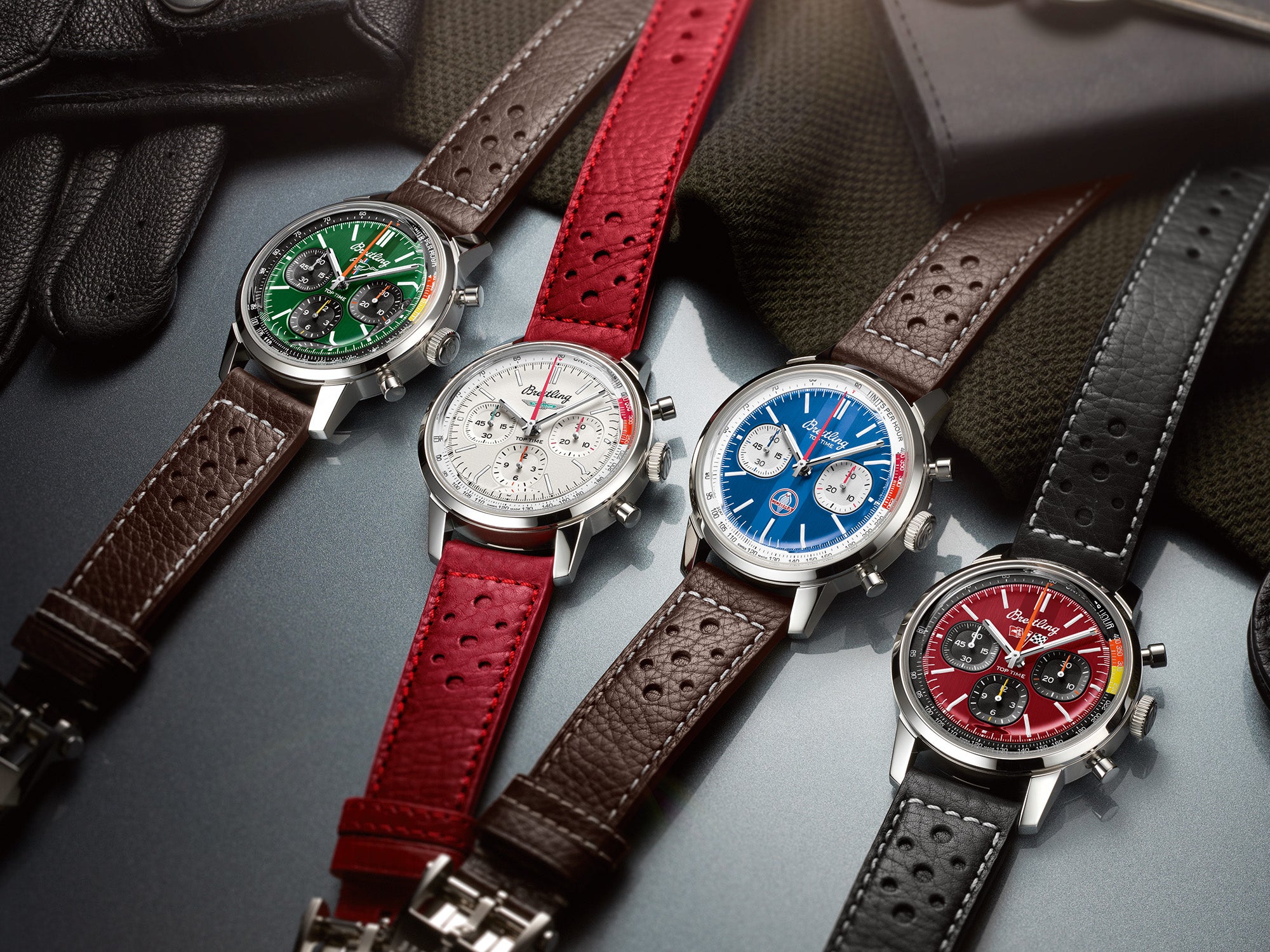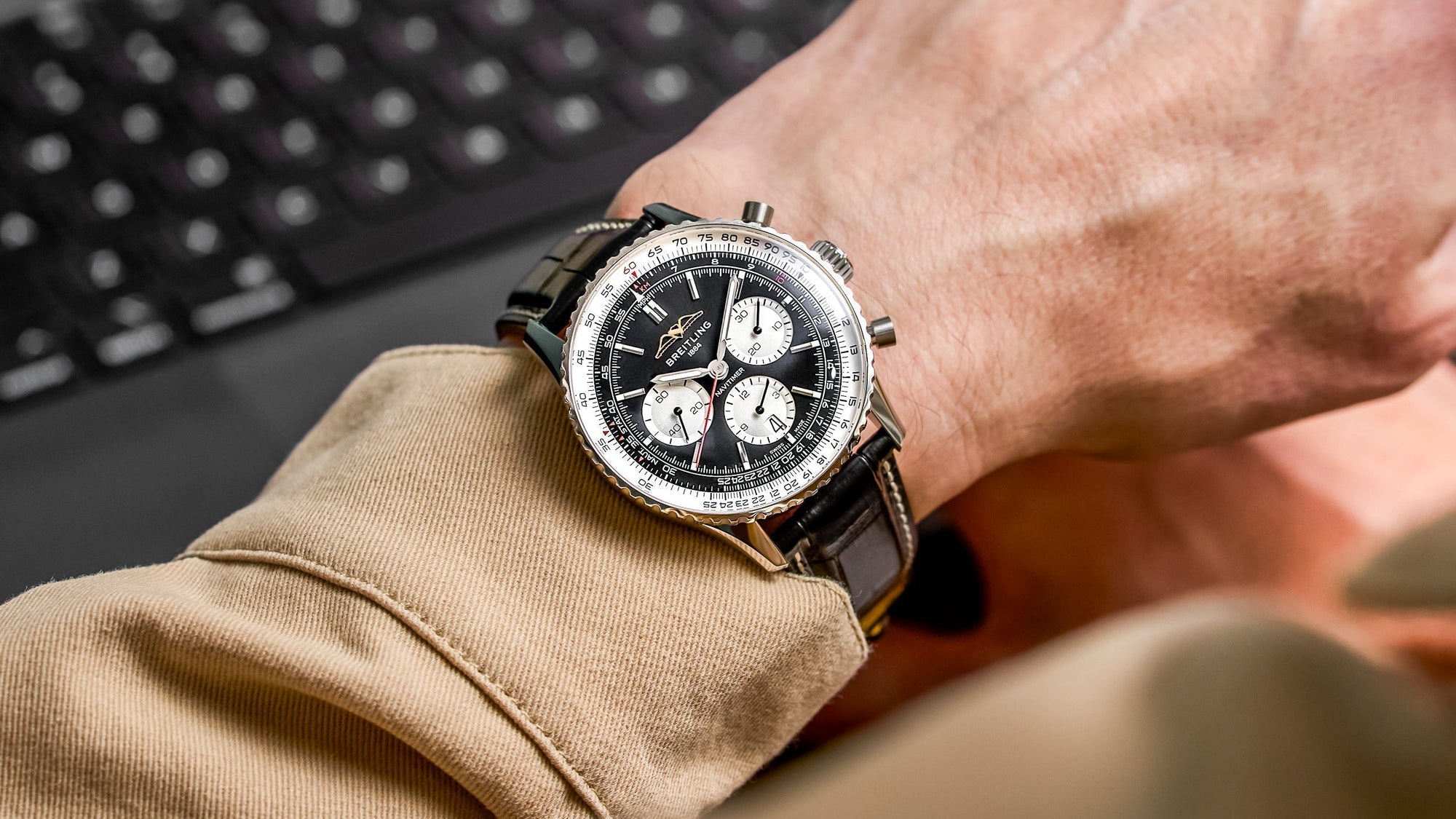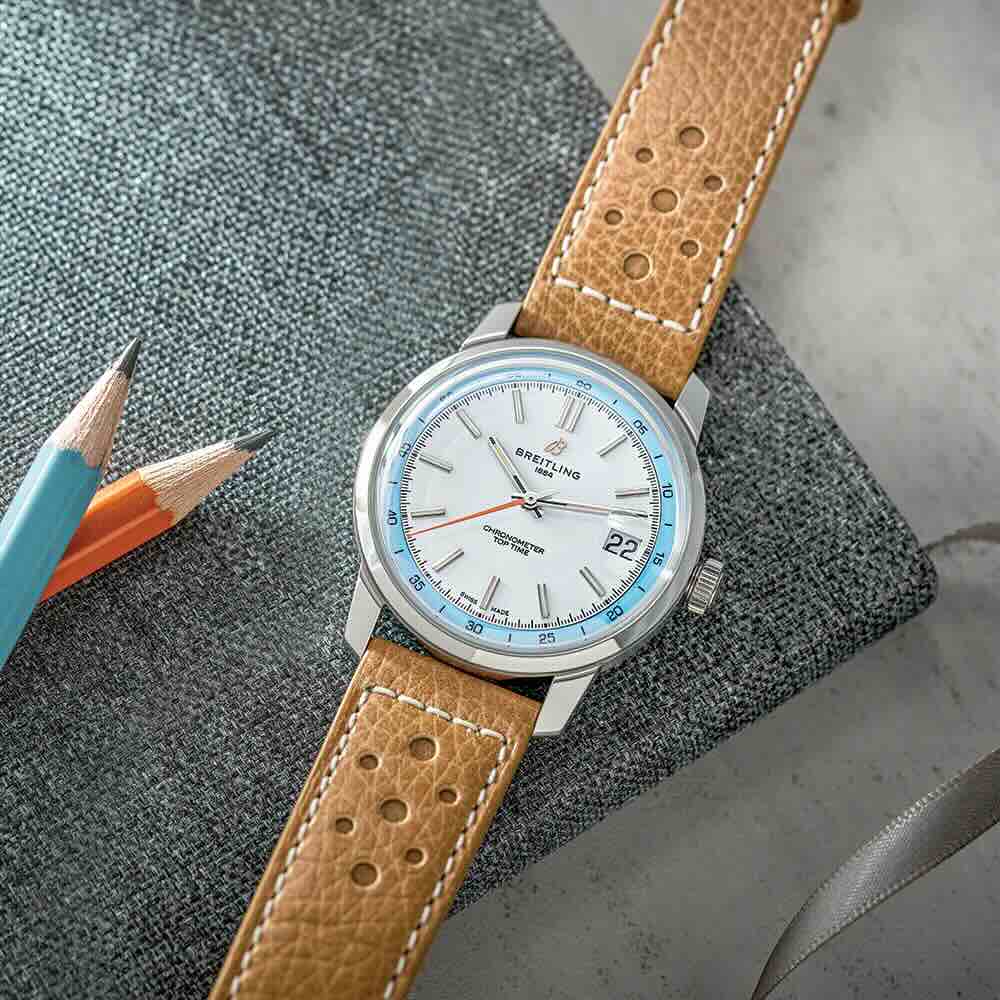Breitling and Rolex are two Swiss watch titans that play in many similar arenas of watchmaking, each in its own distinctive way. As with comparing any watch brand against another, the question of “Breitling vs. Rolex” or “Rolex vs. Breitling” largely comes down to personal questions of style, wearability, and, let’s face it, budget. But both brands have a lot to offer in terms of their impressive history, worldwide popularity, and ongoing quest for excellence in their respective specialties. Here’s a head-to-head rundown focusing on several key areas of similarity and contrast.
Origins And Some History
Both Rolex and Breitling are quintessentially Swiss watch brands, though both of them trace their roots to founders with German heritage.

Hans Wilsdorf, founder of Rolex
Rolex founder Hans Wilsdorf was raised in Kulmbach, Germany and began his career in the Swiss watch industry in 1900 as a clerk at the watchmaking firm of Cuno Korten in La Chaux-de-Fonds, Switzerland. Wilsdorf shortly thereafter moved to London and in 1905 partnered with another businessman named Alfred Davis to establish Wilsdorf & Davis, the company that would become Rolex. Wilsdorf & Davis, based in London’s Hatton Garden commercial district, was founded with a mandate to make reliably precise watches at affordable prices.
In 1914, days before the outbreak of World War I, Wilsdorf changed the name of the company to “Rolex,” a name that could be easily pronounced and understood in any language for the firm’s growing international clientele; Wilsdorf has claimed the name simply came to him during a carriage ride, with perhaps “a genie” whispering it in his ear. In 1919, responding to England’s heavy post-war export duties on materials like gold and silver, which Rolex was using for watch cases, the company moved its headquarters to Geneva, Switzerland, where its offices remain to this day, with the main manufacturing hub eventually being established in the Geneva suburb of Plan-Les-Ouates.

l-r: Léon, Gaston, and Willy Breitling
Léon Breitling, born the son of German immigrants to the Swiss village of Saint-Imier in 1860, didn’t need any genies to suggest a name for the watchmaking company that he founded in 1884. He simply named it after his family from the start, establishing Breitling SA (originally G. Léon Breitling) in his hometown at the tender age of 24. Léon Breitling was deeply interested in the emerging technologies of the time and, from the outset, placed his company’s focus squarely on making precise timing mechanisms for military usage, competitive sports, and for conveyances that were just starting to make their way to the mainstream, like automobiles (in 1885) and airplanes (in 1903). Léon’s son Gaston Breitling took over the business in 1914, followed by his son Willy Breitling in 1927, and the firm remained in family hands until 1979.
Oyster Case, Slide-Rule Bezel, & Early Innovations
Rolex and Breitling both achieved several watchmaking milestones during their earliest years in operation, under the guidance of their visionary founders. Rolex’s most impactful contributions to horological history were in the areas of water resistance (the Oyster case), self-winding technology (the Perpetual movement), and bringing calendar displays to the mainstream (the Cyclops date magnifier and Datejust design). Breitling’s innovations were more tied to its original mission statement of developing highly precise stopwatches and other timing devices.

Hans Wilsdorf was one of the earliest proponents of making wristwatches more waterproof. It was a challenge that had plagued watchmakers for years, ever since pocket watches began fading from common usage in favor of the wrist-worn timepieces that gained wide acceptance in the wake of World War I. Wilsdorf’s 1926 invention, the so-called Oyster case, proved to be (no pun intended) a watershed for an evolving industry. Named after the bivalve mollusk that inspired its two-part, clamping “shell” design, the case combined a threaded, hermetically sealed caseback and a crown that screwed securely into the side for a water resistance never before achieved in watches.
The first Oyster watch, which took its name from the inventions, debuted that year. The following year, in what would be the first of many celebrity-driven marketing initiatives over the years, Rolex partnered with British swimmer Mercedes Gleitze, who famously wore a Rolex Oyster watch on a necklace in her bid to become the first woman to swim the English Channel.

Rolex's first "Perpetual" Caliber, 1931
Wilsdorf’s other quest — making watches that wound themselves — came to fruition with the development of a patented, self-winding movement with a weighted mass that served to wind the mainspring via the motion of the wearer’s arm. Rolex watches were already renowned for their accuracy, having won chronometry competitions as early as 1910, and this was the latest step in making them even more reliable for everyday wear.
Because this type of movement kept the watch constantly wound as long as it was being worn, it was referred to, then and now, as “Perpetual.” It wasn’t the first self-winding, or “automatic” movement in a wristwatch — that would be the one patented by British watchmaker John Harwood in 1923 — but it was a development that spurred other watch manufacturers to begin adopting the technology in their own products. Most of Rolex's most popular models today fall under the Oyster Perpetual banner, meaning they combine the waterproof case with the self-winding movement.

A Rolex Submariner with a Cyclops lens over the date
One of the earliest of these Oyster Perpetual wristwatches was the classic Datejust, which debuted in 1945. It’s considered a fairly simple, straightforward dress watch today, albeit a very luxurious one, but it was a pioneer of two elements, one of which can be found throughout the watch industry; the other, still closely associated with Rolex. The first was the addition of a date display in a window at 3 o’clock. The second (which actually didn’t appear until 1948) was the “Cyclops” lens over said window, which magnified the date numeral by a factor of 2.5 for greater legibility at a glance. Legend has it that Wilsdorf came up with the feature after his second wife lamented to him how difficult it was for her to read the date on her watch, and that the idea came to him after a droplet of water fell onto his watch’s crystal over the date window while he was washing his hands in the bathroom.
Of course, both of these brands have their share of history in the Breitling vs Rolex comparison of early innovations. Breitling made significant leaps forward in chronographic technology throughout its first three generations of family ownership and eventually integrated itself, perhaps more closely than any other watchmaker, into the growing field of aviation. As early as 1889, founder Léon Breitling received the first of several patents, for a pocket watch chronograph that he developed that was ahead of time in the areas of legible design, manufacturing simplicity, and easy maintenance. Others that followed included one for a movement with an eight-day power reserve, in 1893, a stopwatch accurate to an unprecedented ⅖-second in 1896; and a tachymeter-equipped dashboard clock for automobiles called the Vitesse in 1905. (Interesting sidenote: the Vitesse also enabled police to clock the speeds of drivers, giving rise to the first speeding tickets in Switzerland.)

After Léon’s death, son and successor Gaston made his own historical mark with the invention, in 1915, of one of the world’s first chronograph watches with a separate pusher, above the crown, to control start, stop, and reset functions; previously, all of these functions had been embedded in the crown itself. Willy Breitling took over after his father’s death in 1927 and soon took the latter’s innovation to the next level, patenting the first wrist chronograph with two pushers separate from the crown. This “dual-pusher” design is today the standard for most chronograph wristwatches, while the old-school “monopusher” is mostly reserved for vintage-look special editions and other such outlier products.

The original Breitling Chronomat, 1941
With a second World War looming in 1938, Breitling took its first steps to becoming the pilot-watch titan that it is today. Breitling’s Huit Aviation Department, founded that year, made very precise and robust timing instruments, including chronograph clocks, for military planes’ cockpits, which were notable for their eight-day power reserves (“huit” is French for “eight). Britain’s RAF began using these instruments in 1939. Just a few years later came another patented invention, one that come to play a vital role in Breitling’s growth as a brand: the first timepiece equipped with a logarithmic scale on its rotating bezel that could be used by wearers to make calculations and conversions.
Based on the E6B slide rule devised by mathematician Robert Marcel — which enabled users to convert between standard miles, kilometers, and nautical miles, the most important units for aviation — the multifunctional scale could be used in conjunction with the watch’s chronograph function to determine factors such as fuel consumption, distance traveled, and climb and descent rates. Breitling called this versatile tool watch the Chronomat — melding “Chronographe” with “Mathématique” — and released it to the public in 1941. This version of the Chronomat did not have much staying power after World War II, but its signature slide-rule bezel was slated for a big return about a decade down the road.

Dive Watches: Breitling Superocean And Rolex Submariner
Rolex made one of the first and easily the most influential of diver’s watches, the Submariner, as well as its deeper-diving descendants, the Sea-Dweller and Deepsea; while Breitling explored new areas of aquatic utility with its Superocean line, including the incorporation of chronograph functions.

Rolex Oyster Perpetual Submariner
Rolex’s Oyster case had been around since 1926, but it wasn’t until 1953 that its waterproof capabilities were pushed to the next level. That year, in which the popularity of Scuba diving was on the rise and watchmakers strove to fill the need for watches that could withstand deeper underwater pressures as well as track immersion times, Rolex unveiled the first Submariner, Ref. 1604. The Submariner was touted as the first commercial watch that was waterproof to 100 meters — a significant claim, as the Blancpain Fifty Fathoms, which had preceded it to market, was tested only to the 91.44 meters that matched up to its name.
The first Submariner established the template: 37mm steel Oyster case, black dial with inverted triangle at 12 o’clock, alternating circle and bar indexes at the hour markers, and a rotating bidirectional bezel with a 60-minute scale that a diver could set to keep track of his time underwater. Subsequent references of the Submariner, starting with the Ref. 6205, added the familiar Mercedes handset and even more robust water-resistance ratings — 200 meters and eventually 300 meters, which is the standard for the model today. (The case sizes also grew, to a standard of 40mm to 41mm in modern models, and the movements underwent significant revamps as Rolex took most of its production in house.) In 1979, the Submariner adopted the unidirectional diver’s bezel which Blancpain had introduced years earlier for increased security, a feature that continues to define all Submariner models.

The Rolex Submariner’s journey from a tool watch aimed at diving enthusiasts to one of the world’s most coveted luxury items began in 1962, when its appearance in the film Dr. No forever established the model as the original “James Bond watch.” Actor Sean Connery famously wore a Submariner, specifically the Ref. 5638, notable for its oversized 8mm “Big Crown” and aluminum bezel insert, in the next two movies in the long-running spy series as well — From Russia with Love in 1963, and Goldfinger in 1964.Nearly every luxury divers’ watch on the market today owes some stylistic debt to the Submariner, which remains to many collectors the gold standard of the category.
The Submariner’s association with James Bond certainly didn’t hurt its case, nor did its proven track record as a diving instrument, worn by pioneers including Jacques-Yves Cousteau. The Submariner begat other models like the Sea-Dweller, which had a very similar design but added a helium-release valve for even deeper descents, like saturation diving in a pressure-regulated diving bell; and the Deepsea, which has set records for a watch immersed in the deepest ocean areas on the planet.

Breitling Superocean Ref. 1004 and Ref. 807 (1957)
A few years later into the Scuba-happy 1950s, Breitling introduced its own purpose-built diver’s watch, the Superocean. Launched in 1957, the Superocean commemorated 25 years at the company helm for Willy Breitling. As per the company’s customary innovative spirit, its entry in the burgeoning dive-watch genre took things to new levels in a couple of respects. The Superocean family began with not one but two watches: Ref. 1004, a three-handed diver in a 38mm stainless steel case containing an outsourced movement; and Ref. 807, one of the earliest dive chronographs, in a 39mm steel case, which many believe may have sported the first “reverse panda” dial, i.e. white subdials on a black background.
Both versions of the Superocean were noteworthy for the concave shape of their rotating dive-scale bezels, their distinctive arrow-and-sword handset, and their long, thin triangular hour markers, different from the geometrical indexes favored by most of the watch’s predecessors. Most importantly, the Superocean’s case was water-resistant to 200 meters, double that of the Rolex Submariner at its debut.

Modern Breitling Superocean
In 1964, Willy Breitling turned his attention to upgrading the Superocean’s chronograph function for even greater diving utility. His team developed an all-new movement with a large, luminous central minutes hand for the chronograph, rather than a traditional seconds hand, which made a complete rotation around an outer 60-minute scale once per hour instead of once per minute. This made the elapsed time underwater more readable than it would have been on standard, smaller chronograph subdials. To solve the problem of how a wearer might see at a glance if the watch is running without the aid of a moving seconds counter, Breitling added a small dot-shaped aperture above 6 o’clock, which would be filled in with black to blend in with the rest of the dial when the chronograph is switched off, and filled with white to indicate when it was running.
The watch that contained this movement, the now-rare Superocean Ref. 2005, eventually picked up the nickname “Slow Motion” Superocean, for its slow-moving minutes hand, a feature not found on any other dive watch or chronograph at the time. After several generations of design evolutions and line extensions (including the still-extant Superocean Heritage models, which revived elements of the 1957 originals), Breitling introduced a new line of Superocean models in 2022 that hearkened back to the “Slow Motion” watches. Unlike those ‘60s predecessors, however, the contemporary models use a conventional running seconds hand in the center.
The large, luminous square of the historical watch’s “slow motion” hand now finds a home on the main minutes hand, paired with a wide sword hour hand. The chunky square indexes, also a nod to the vintage models, are luminous-coated for optimum legibility. The dive-scale inserts on the bezels are made from scratch-proof ceramic. Intended for lifestyle situations as well as underwater sport, the new Superocean comes in a variety of executions and case materials including one that uses 18k rose gold for the case, crown and buckle.

Pilots’ Watches: Breitling Navitimer And Rolex GMT-Master
When it came to influences on watchmaking, the 1950s were not just a decade defined by the proliferation of the dive watch; it was also a time of unprecedented growth in commercial aviation, fondly recalled by many as the “Golden Age of Flight” — an era in which airline pilots and the international jet-setters they ferried around the globe were both seeking suitably cosmopolitan timepieces for their work and lifestyles. Both Rolex and Breitling delivered in a big way, making two of the most iconic timepieces associated with aviation.

Modern Rolex GMT-Master "Pepsi"
Like the Submariner that had preceded it a year earlier, the Rolex GMT-Master, introduced in 1954 but not on the market until 1955, was both trend-setting and genre-defining. It was the first watch capable of displaying the time in two separate time zones by means of a central 24-hour hand and a bidirectional rotating 24-hour bezel with a bicolor “day/night” color scheme. The initials in the watch’s name signify “Greenwich Mean Time,” the system of world timekeeping based on the calculation of mean solar time from the Royal Observatory in Greenwich, London.
Notably from an aviation history perspective, its dual-time functionality was an innovation devised for, and developed in cooperation with, the original watch’s intended users: pilots for Pan American Airlines, who wanted a tool watch that enabled them to track the time on long-haul and international flights in both their home city, and their flight’s destination city, anywhere in the world. The first-generation GMT-Master, Ref. 6452, had a bezel divided into two equal sectors of red and blue, a clever and eye-catching visual shorthand to identify daytime and nighttime hours on the 24-hour scale.

This red-and-blue “Pepsi” bezel would herald other popular colorways with pop-cultural nicknames, like the red-and-black “Coke” bezel in 1983, the blue-and-black “Batman” bezel in 2013, and many other iterations since. Once again, an appearance in the James Bond movie mythos helped garner the original GMT-Master its still-substantial pop culture cred: Honor Blackman wore the “Pepsi” in Goldfinger in her role as femme fatale (and stunt pilot) Pussy Galore, forever lending that watch an additional nickname based on her character. While other watchmakers, before and since the introduction of the GMT-Master, have established various ways of displaying and tracking two or more time zones, it is Rolex’s design that has proven the most impactful and enduring, and the one most emulated by other brands looking to entice world travelers. The number of bicolor 24-hour bezels out there in the watch world should be plain enough proof.

Breitling Navitimer B01
In terms of aviation-related instruments, Breitling had much more a track record, took a different tack from both a design and functionality standpoint and in the process created what many consider the quintessential airline pilot’s watch. The key element of the Navitimer, launched in 1952, was the re-introduction of the bidirectional, circular slide-rule bezel that had made its debut on the original wartime version of the Chronomat in 1940. In conjunction with the watch’s built-in chronograph — still Breitling’s specialty — the rotating scale could be used by a pilot to determine factors such as fuel consumption, distance traveled, and climb and descent rates.
The bezel’s beaded edge was perfectly designed so that a wearer could easily grip and operate it even wearing gloves. Deriving its name from a portmanteau of “Navigation” and “Timer,” the original Navitimer Ref. 806 established the model’s now-familiar three-register arrangement: elapsed hours, elapsed minutes, and running seconds displayed on subdials at 3, 6, and 9 o’clock, respectively. At 12 o’clock on the earliest Navitimer models was the stylized airplane-silhouette logo of the Aircraft Owners and Pilots Association (AOPA), an advocacy group established in 1932, to whose members the first Navitimers were marketed.

Breitling initiated a partnership with star actor and licensed pilot John Travolta in 2009, which brought the model's high-flying cool factor to an even wider audience. A year later, In 2010, Breitling started equipping the Navitimer, which with its own in-house Caliber B01, which features an integrated column-wheel chronograph function and a substantial power reserve of 70 hours. The Navitimer, now available in dozens of iterations, remains one of the most instantly recognizable Swiss watches in the world, with its complex flight-computer-for-the-wrist styling. A handful of other pilot’s watches have adopted the slide-rule bezel but none have made it as much of a stylistic signature as the Navitimer.

Chronographs: Breitling Top Time And Rolex Daytona
In the chronograph matchup between Breitling and Rolex, Breitling has the obvious edge. Nearly all of Breitling’s most popular models include the popular complication, including the Navitimer, Chronomat, Avenger, and Premier, and chronographs even play a role in the diving-oriented Superocean family. Rolex has just one dedicated chronograph in its portfolio, the Daytona, and yet that watch is arguably not only the most coveted Rolex for the Crown’s legions of fans; its legendary origins in the world of auto racing give it a motorsport mystique that few watches can match. Breitling, which can claim a heritage of making timers for automobiles that goes even further back, has recently embraced that past with a resurrection of the 1960s Top Time.

Rolex Cosmograph Daytona
An undisputed trailblazer in many areas of the watchmaking industry, Rolex was relatively late to the game when it came to chronographs — at least compared to longtime specialists in the field like Breitling, as well as other competitors like Longines and Heuer (later TAG Heuer), all of which had mastered and even made improvements on the chronograph before the 20th Century. Rolex had dabbled with chronograph models intermittently since 1937, but none had achieved much success or been particularly memorable.
Then came 1962, when Rolex became official timekeeper of the Daytona 500 stock car race and seized upon the opportunity to put its stamp on the emerging genre of wrist-worn chronographs designed for racing drivers. One year later, Rolex released the Ref. 6239 Cosmograph, nicknamed the “Daytona” (though the name had yet to appear on the dial), its now-famous racing-inspired chronograph watch. It was notable for its three-register dial and engraved tachymeter bezel. It was the ultimate evolution of other “pre-Daytona” wristwatch chronographs that the company had released, to little acclaim or success at the time, in the 1950s.

Paul Newman and his Rolex Daytona
Part of the reason for the Daytona’s ascent to icon status was the star power bestowed upon it by its most famous wearer, actor Paul Newman, who embarked upon a successful second career as a racing driver after starring in the 1969 movie Winning. The model he wore, and which is now nicknamed for him, is one of the rarest collectible timepieces on the secondary market, with an off-white-and-black “panda” dial layout, square-tipped hash marks and Art Deco-style numerals. Like a high-performance race car upgrading to more powerful engines, the Daytona continued throughout its decades on the market to stay on the cutting edge of chronographic excellence.
The original Valjoux movement in the original references eventually gave way to the Rolex Caliber 4030, a heavily modified version of Zenith’s legendary high-frequency El Primero (you can learn more about it here) in the late 1980s. That movement was superseded by the in-house Rolex Caliber 4130, with a column-wheel chronograph mechanism and a host of Rolex-patented technical details.

Breitling Top Time Classic Cars Edition "Shelby Cobra"
Breitling, as has been previously stated in this article, is a chronograph king from way back and offers no shortage of chronographs in its lineup, but the one that speaks most loudly to the car and motorsport enthusiasts who made the Daytona such an icon is the Top Time, a watch released — like the Daytona — in the 1960s, but has only recently rejoined the collection. It is yett another brainchild of the prolific Willy Breitling, who realized around the dawn of that influential decade that chronographs were breaking out of their traditional role as timing tools and growing in mainstream appeal. This realization led him to develop a chronograph watch for a younger, more active generation of wearers, an unconventional timepiece that was more “style object” than “tool watch.”
Designs began in 1962 and two years later, the model hit the market to swift success, gaining a fan base among style-conscious young adults, particularly those also interested in the era’s muscle cars and motorbikes. The Top Time was notable for its water-resistant monocoque case, its mushroom-style chronograph pushers, its easy-to-remember alliterative name, and the dynamic versatility of its dial options: the Top Time offered three different chronograph scales on its border: a tachymeter for calculating driving speeds, a pulsometer for checking heart rates, or a decimal scale for making precise stopwatch calculations to the 1/10th second.

The Breitling vs. Rolex comparison even extends to 007 here, as the Breitling Top Time boasts its own milestone appearance in a James Bond movie, albeit in a more fleeting role than Rolex’s Submariner (or, more recently, Omega’s Seamasters). In a key scene of 1964’s Thunderball, Sean Connery’s Bond swaps out his Submariner for a heavily modified Breitling Top Time Ref. 2002, a steel-cased, black-dialed chronograph with two white subdials, applied baton hour markers, and a tachymeter scale surrounding the dial. In the movie’s fictional universe, the watch — one of many gadget-packed timepieces assigned to Bond by MI-6 weapons supplier Q throughout the film series — is also equipped with a built-in Geiger counter; Bond uses it to track a cache of stolen nuclear warheads hidden deep underwater by his adversaries from the criminal organization SPECTRE.
The only Breitling watch worn by any James Bond actor on screen, the movie-worn timepiece sold at auction for more than 100,000 British pounds in 2013; in 2020, the watch inspired a limited edition revival under Breitling’s current ownership, led by watch-industry veteran Georges Kern. That 2,000-piece “Zorro” edition swiftly sold out, moving Kern and Breitling to launch a full-scale revival of the Top Time, leaning in to its ‘60s car-culture vibes with designs inspired by classic roadsters like the Ford Mustang, Chevy Corvette, and Shelby Cobra. More recently, the Top Time collection has expanded into non-chronograph, three-handed editions that showcase Breitling’s first-ever in-house, time-only movement, Caliber B31.
Rolex “Testimonees” And Breitling “Squads”
Both Rolex and Breitling boast an impressive roster of famous fans and official brand partners. Rolex has long called its official endorsers “Testimonees,” while Breitling, at least as of the current Kern era, groups them into “Squads.”

Hans Wilsdorf was a master marketer and Rolex has been big in the area of brand-building sponsorships from its earliest days. Among its most historical initiatives were its partnership with British swimmer Mercedes Gleitze, who famously wore a Rolex Oyster watch in her 1927 bid to become the first woman to swim the English channel; and the company’s supplying of early Rolex Explorer watches to accompany Sir Edmund Hillary’s milestone summit of Mount Everest in 1953. Rolex became the official timekeeper of auto racing’s Daytona 500 in 1962 (naming its famous chronograph watch after the race a year later), kicking off a long string of motorsport sponsorships.
Today, Rolex maintains a strong branding presence in several sports, including golf, tennis, motor racing, equestrian, and yacht racing. Rolex’s multigenerational group of “testimonees” (aka brand ambassadors) include world-renowned figures such as Arnold Palmer, Jack Nicklaus, Tiger Woods, and Jordan Spieth in golf, Bjorn Borg and Roger Federer in tennis, Sir Jackie Stewart and Mark Webber in auto racing, and Sir Ben Ainslee in Olympic sailing. All of these, of course, are in addition to late, legendary figures like the aforementioned Newman and Connery, who will forever be associated with Rolex.

Breitling watches have been spotted on the wrists of boldfaced names for decades, from renowned music legends like Miles Davis and Serge Gainsbourg, to star athletes like Boomer Esiason and Wayne Gretzky, to actors including Leonardo DiCaprio (who wore a Chrono Avenger in 2006’s Blood Diamond, and Jerry Seinfeld, who famously wore Breitlings throughout the long run of his eponymous ‘90s sitcom. Recently, Breitling has stepped up its celebrity endorsement campaigns, organizing its ambassadors into “Squads” — i.e, a “Surfer Squad,” fronted by Kelly Slater, an “All-Star” Squad,” which includes NBA “Greek Freak,” Giannis Antetokounmpo and NFL quarterback Trevor Lawrence; and a “Cinema Squad,” whose most high-profile members include Brad Pitt and Charlize Theron.

Breitling Vs. Rolex: Final Thoughts
If you’ve followed this far, it should be clear that both Breitling and Rolex have earned their upper-echelon status among Swiss watch brands, and that each can claim distinct areas of strength. Breitling (which you can learn more about here) is older, with a mastery of chronographs, and a breadth of chronograph styles, that few brands including Rolex could rival. It is indisputably the watchmaker most closely associated with aviation, boasting in its lineup more watches that evoke the romance of flight more than any other. Rolex (which you can learn more about here), as even the most casual of industry-watchers knows, is unmatched in its contribution of iconic, impactful timepieces to watchmaking history and, even more impressively, maintaining and even growing their popularity and relevance among enthusiasts decades after their debuts.
On the secondary market for pricing, Rolex can’t really be touched by any maker except perhaps Patek Philippe: the Ref. 6239 “Paul Newman” Daytona owned by Newman himself and sold at auction in 2017 still holds the title of third-most expensive watch ever sold, at an astonishing $17.75 million. Breitling’s most expensive model sold at auction, according to sources, is a diamond-studded Bentley Flying B J28362 timepiece in white-gold, a product of Breitling’s longtime collaboration with Bentley Motors, far behind at $255,500. Perhaps Brad Pitt or another of Breitling’s “Squad” members will have something to say about that in years to come.






















































0 Comments